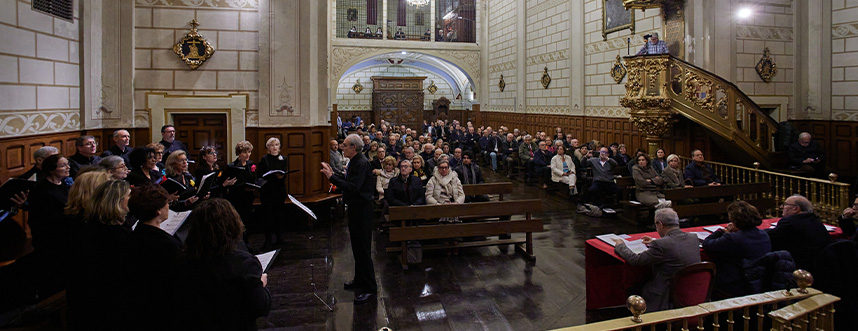Ricardo Fernández Gracia, director of the Chair of Heritage and Navarrese Art of the University of Navarra, publishes a book on the Virgen de las Maravillas of the Recoletas of Pamplona.
The book has been edited by the Publishing Services of the academic center and sponsored by the Fuentes Dutor Foundation.

PhotoJoséCastells/
The monograph on La Virgen de las Maravillas de las Agustinas Recoletas de Pamplona. History, art and devotion, is the result of a project of research, conceived and thought of years ago, but realized and made a reality during the last year. It is the work of Ricardo Fernández Gracia, Senior Associate Professor of Art History at the University of Navarra, director of its Chair of Heritage and Navarrese Art and corresponding member of the Royal Academy of History.
Some facts of subject religious, with enormous cultural content, became, in past centuries, sociological. Among them, we can cite what happened, in the capital of Navarre, with the cult and feast of Our Lady of the Wonders of the Augustinian Recollect Nuns, from 1656 until the middle of the twentieth century. Its entrance in art, literature, popular piety and recreational and festive celebrations, in Pamplona, was a phenomenon in crescendo in which all the social fabric of the city was involved.
In 1656, the image arrived at Recoletas, in the very seiscentist context of a society captivated by celestial phenomena and highly submissive to the senses, always more vulnerable than the intellect. If we add to this the protagonism in the finding and submission of the icon by Fray Juan de Jesús San Joaquín, a discalced Carmelite layman, who was talked about in the Court, in San Sebastián and in many places for the miracles he performed, we have the components for the image to have a halo of mystery and a fame of doing wonders that reached very far, even to the lands of Novohispania.
Those who have written about the image always repeat the finding and its circumstances, but hardly any research has been done on the sculpture itself, its trousseau, mantles, jewelry, its archangelic altarpiece, unique of its kind in Navarre, its cult, miracles and its multiplied image, both in painted trompe l'oeil, as well as in engravings, lithographs and photographs.
Dealing with all this has led the author of the monograph to contemplate in a multidisciplinary way very different objects, most of which are preserved in the cloister. To do so, he has consulted exhaustively all the funds, referring to topic, in the conventual file . For specific and precise questions, searches have been completed in the file General of Navarra, in different parish archives and in those of some sanctuaries, such as Roncesvalles or Loyola.
The first chapter focuses on a contextualization of the monastery, its architecture, its altarpieces, the most important pieces of its cloister, the daily life of the nuns through the centuries and the great festive moments throughout the year.
The second chapter gathers everything related to the arrival of the image by the hands of Brother Juan de Jesús San Joaquín, in 1656 and the election of degree scroll of the invocation.
The third chapter deals with the image itself and the places of its worship. At first, between 1656 and 1674, it was placed in the chapterhouse conference room and, more specifically, in a cabinet with gilded doors with paintings of the epithets of the litanies, made at the tip of a brush. In 1674, thanks to a name that until now has been little mentioned, Juan Antonio Berástegui, it was possible to build the altarpiece for the image. From the iconographic point of view, it is the only one with the seven archangels in Navarre.

Photo by Jesús Garzaron
The fourth chapter is dedicated to the reproductions of the image. Trompantojos painted in Pamplona and Puebla de los Ángeles in New Spain and various engravings in the 18th century were witnesses to a growing devotion and cult, which spread to many places outside the borders of Navarre.
The ordinary and extraordinary worship is the goal of the fifth chapter. It deals with her annual feast which has had, over time, different dates. The novena that preceded its celebration seems to have taken on a singular development from 1844 onwards, when a text was published for its development and some prayers that would be set to music by different masters.
The last chapter focuses on the study of the mantles, the jewels, the silver crown, the powers of the Child Jesus or the average moon of immaculist content. The greatest effort in this section has consisted of trying to situate chronologically the pieces of the list of the multiple jewels that were arriving to the convent with destiny to the adornment of the image, since the relation does not even count with the year. What is preserved is minimal, but at the same time illustrative of what were the jocalias with which the nuns had to present it in the way that the society of past centuries liked, until 1913, in which the image came to show already without mantles and a large amount of ornaments.
The book has been edited by Publishing Services of the University of Navarra, with the sponsorship the Fuentes Dutor Foundation of Pamplona. The paper edition, which is not for sale, is intended primarily for libraries, academies, archives and research centers. The digital version can be download, free of charge, from the University of Navarra Library 's web page, as well as from the Fuentes Dutor Foundation's web page. The book is in large format (33 x .5 cm.), has been designed by Jesús Irisarri of Pretexto and published by Gráficas Castuera, and has 178 pages. Most of the photographs are the work of José Luis Larrión.
